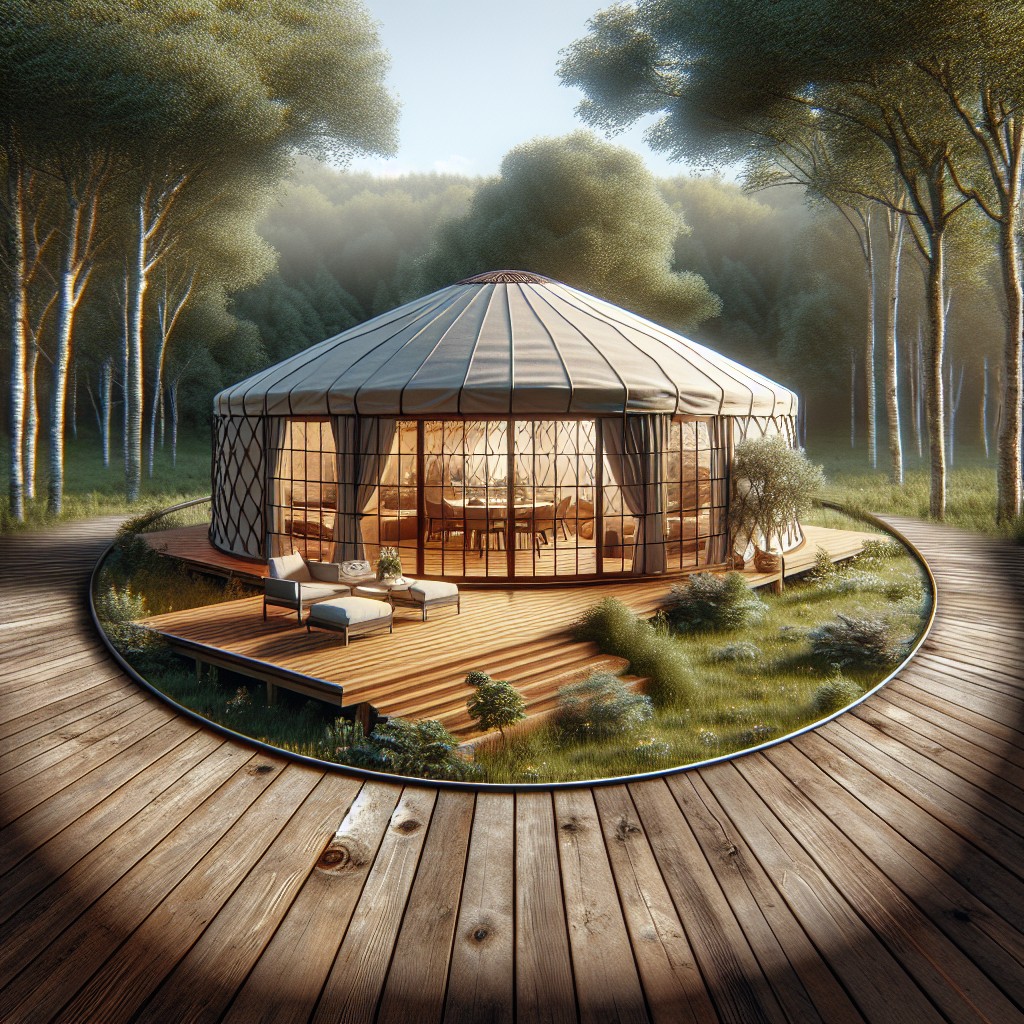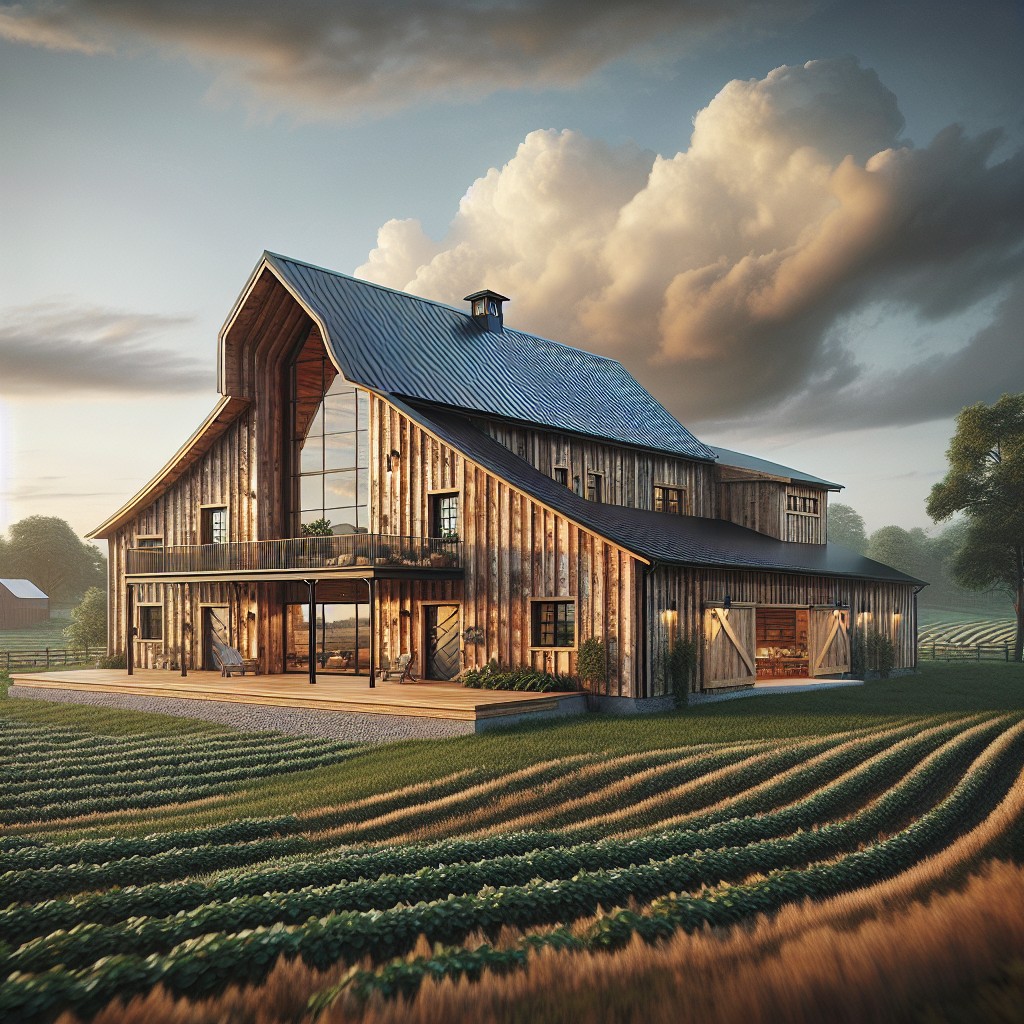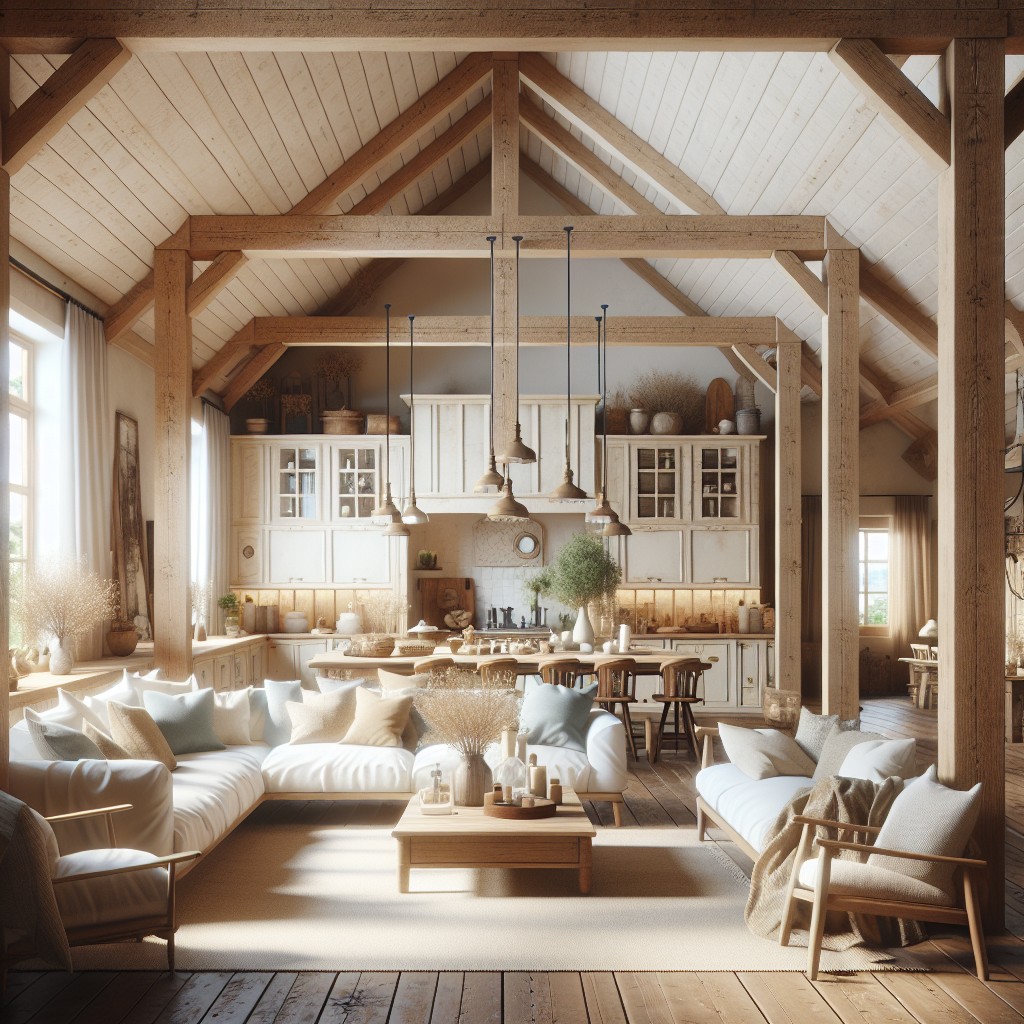Last updated on
Explore the aesthetic allure of red and black barn designs because these timeless structures blend functionality with visual appeal in modern sustainable architecture.
Key takeaways:
- Red and black barns have practical and historical significance.
- Native materials, eco-friendly paints, and reclaimed wood are used.
- Climate and environment affect design considerations.
- Modern elements include oversized doors and solar power integration.
- Interior design elements complement the red and black exteriors.
Historical Significance of Red and Black Barns

Red barns, iconic in rural landscapes, are steeped in practicality, not just tradition. Initially, farmers used linseed oil, mixed with rust to kill moss and mold, to seal the wood, inadvertently creating the red hue. As commercial paints became available, red remained favored for its high visibility against white snow.
Black barns emerged more from a style and functionality perspective. The dark color absorbs heat, facilitating snowmelt around the structure in winter. In Scandinavia, for example, pine tar mixed with charcoal was used for its preservative qualities and the black finish this mixture provided.
The visual contrast of red and black also played a role in delineating different farm functions and creating a visual rhythm in agricultural communities. Today, these colors continue to evoke a sense of nostalgia and a connection to the farming heritage while serving practical purposes.
Symbolism Behind the Red and Black Color Scheme

The striking combination of red and black on barns isn’t solely a design choice; it’s steeped in practicality and tradition. Iron oxide, easily accessible on farms, gave barn paint its classic red tint. This rusty hue helped protect the wood from weathering and decay, while deterring insects that might otherwise nest in the barn’s structure.
The black accents commonly found on barn doors and shutters serve more than an aesthetic purpose. They absorb heat in colder climates, aiding in the melting of snow and ice which can be a burden on farm operations.
Moreover, these colors carry deeper meanings. Red, often associated with strength and vitality, signified the heart of agricultural life, while black represents the solidity and grounding necessary for any enduring structure. Together, they evoke a sense of steadfastness and resilience, embodying the spirit of traditional farm life.
Materials Used in Red and Black Barn Construction
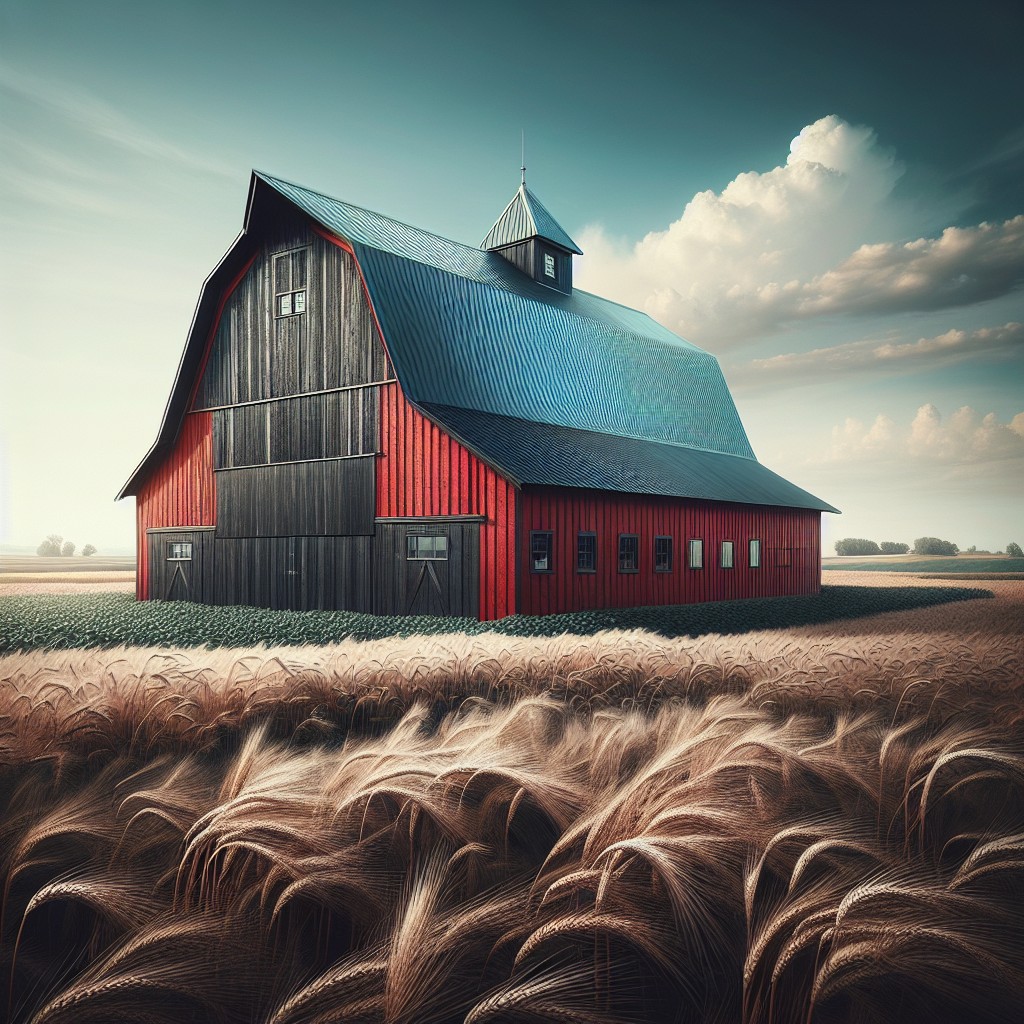
Traditional barns primarily utilized locally sourced materials; wood was the go-to choice due to its widespread availability, durability, and ease of use. The iconic red color often came from a mixture of linseed oil, which served to seal and protect the wood, mixed with rust or ferrous oxide to create a deep, rich hue. This not only added a vibrant color but also prevented fungi and moss growth.
Black barns, on the other hand, saw the use of tar or creosote, which act as excellent wood preservatives, ensuring protection against weather elements. However, contemporary black barns often employ modern paints or stains designed for longevity and low maintenance.
For both red and black barns, metal elements, such as galvanized steel or aluminum, are incorporated in roofing or siding for their strength and resistance to environmental stresses. Advances in materials have led to the use of eco-friendly, low-VOC (volatile organic compounds) paints and stains which contribute to healthier environments and long-lasting color retention. Sustainability concerns have also brought innovations such as reclaimed wood and composite materials into the spotlight, providing alternatives with less environmental impact without compromising on durability or aesthetic appeal.
The Role of Color in Barn Preservation
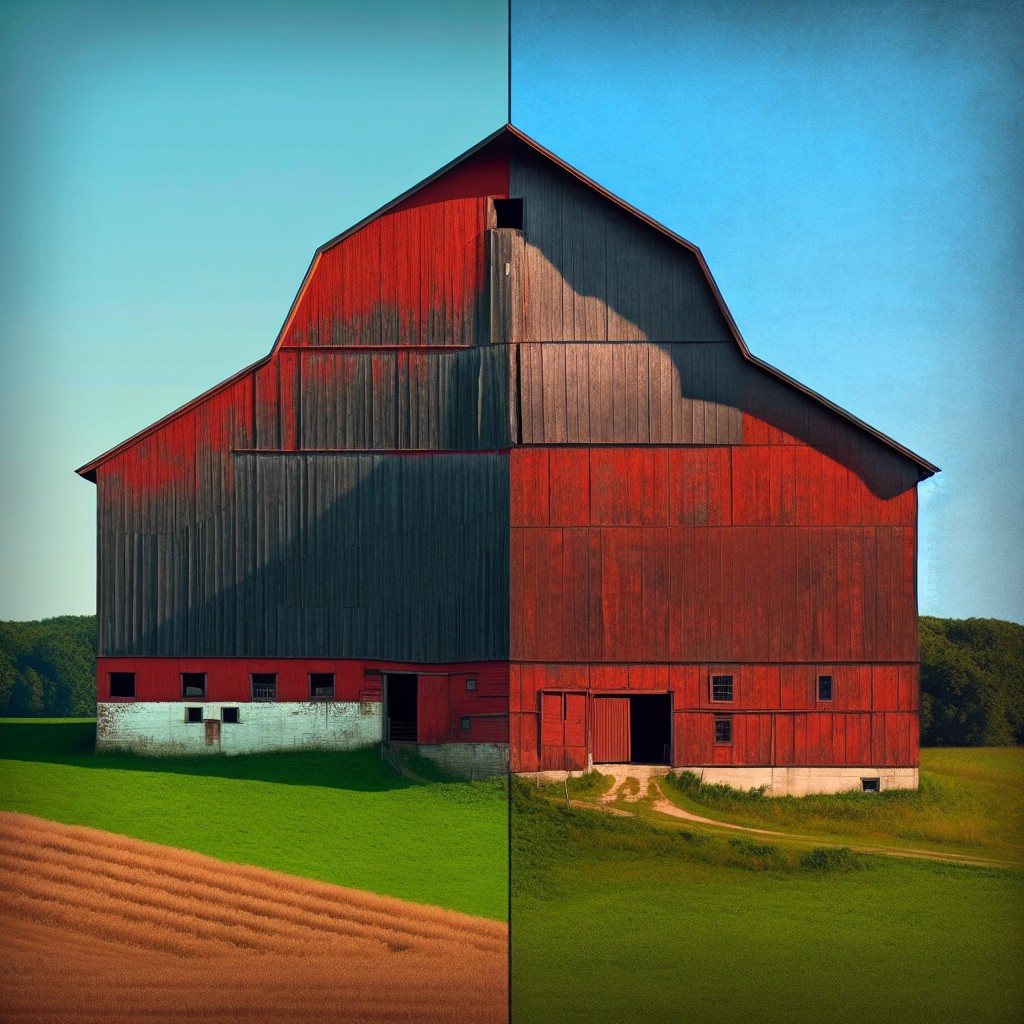
Colors extend beyond aesthetic appeal in barn preservation. The iconic red historically comes from a mixture of iron oxide with milk paint, creating a protective coating against moisture and wood rot. This practical choice helped seal the wood from weathering, inadvertently increasing barn longevity.
Black, meanwhile, absorbs heat, and when used on surfaces, could help melt snow faster during the colder months. This paint could also be created with natural substances like tar, which served to protect the wooden structures from insect damage and fungal decay.
Both red and black paints were cost-effective means of fortifying a barn against the harsh elements, showcasing how traditional color choices contributed to the durability and functionality of these agricultural icons.
Innovative Red and Black Barn Designs and Functionality

In the evolution of barn aesthetics, innovative designs are balancing form with function, ensuring that these structures meet modern needs while retaining their classic appeal.
Incorporating Oversized Doors: Larger doors facilitate movement for machinery and livestock, and when painted black, create a striking contrast against red walls.
Modular Spaces: Movable interior walls and adjustable stalls cater to a variety of purposes, from housing animals to hosting events.
Green Roofs: Integrating green roof systems not only improve insulation but also blend barns into natural surroundings, enhancing the red and black palette with living greenery.
Solar Power Integration: Strategic placement of solar panels on barn roofs can supply renewable energy without compromising design, with black panels complementing the traditional color scheme.
Loft Conversions: Modern barns often feature upper-level lofts for additional storage or living space, maintaining the exterior’s rustic charm while providing functional interior upgrades.
By considering these elements, red and black barns can maintain their iconic look while adapting to contemporary functional demands.
Design Considerations for Climate and Environment
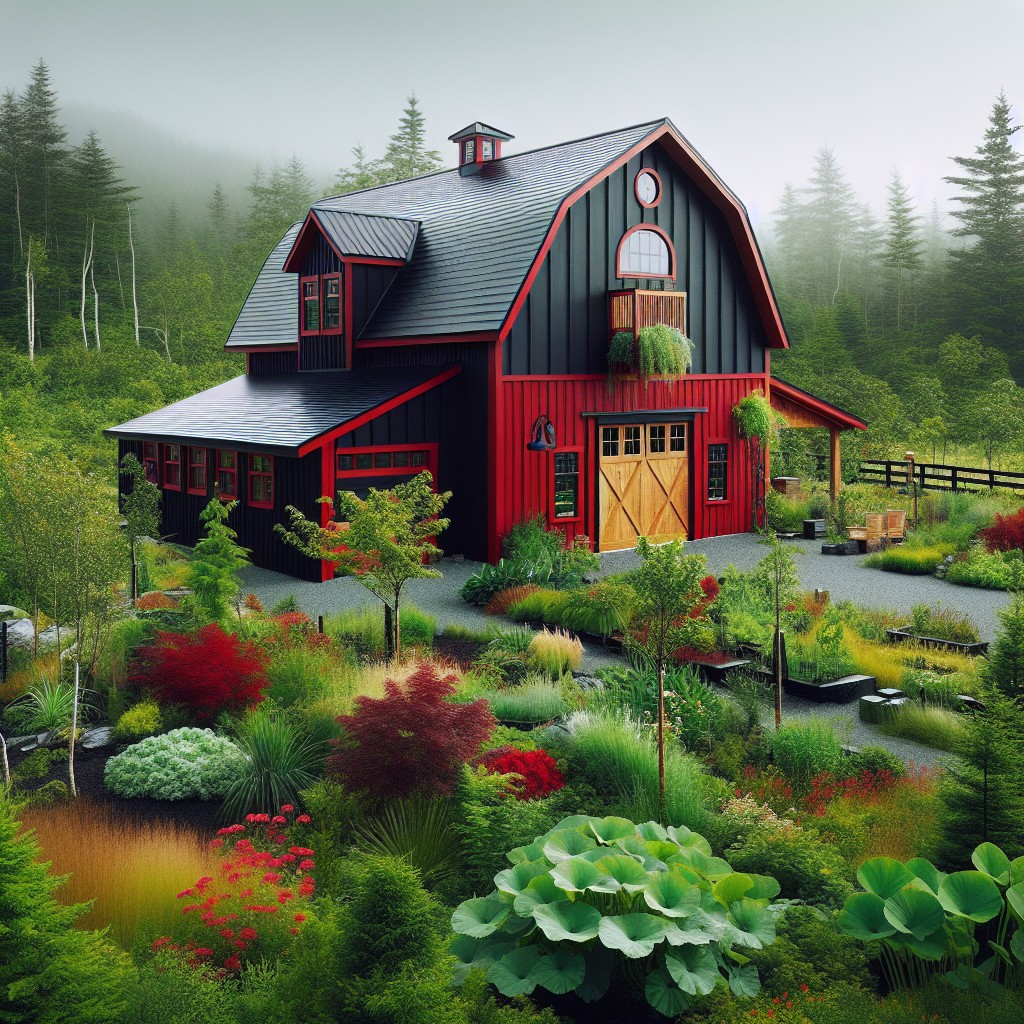
Incorporating local climatic conditions into the design of a red and black barn is crucial for its longevity and functionality.
Insulation and Ventilation: Proper insulation keeps the barn cool in the summer and warm in the winter. Ventilation is equally critical for maintaining air quality and temperature control, especially in regions with extreme temperatures.
Material Choices: Depending on the local environment, materials should be chosen for their durability and ability to withstand the elements. For instance, in areas with high humidity, materials resistant to rot and mold are preferred.
Orientation and Placement: Position the barn to take advantage of natural light, while also providing shelter from prevailing winds and storms. This not only enhances energy efficiency but also protects the barn and its inhabitants.
Roof Design: The shape and slope of the roof can be optimized to prevent snow accumulation in colder climates or to provide shade in warmer regions.
Water Runoff Management: Properly designed gutters and downspouts are essential for directing water away from the barn, preventing erosion and water damage.
Eco-Friendly Paints and Treatments: Select exterior paints and treatments that not only reflect the traditional red and black colors but are also environmentally friendly and suitable for the local climate.
Adapting to the local environment not only ensures that the barn is a sustainable addition to your property but also preserves its aesthetic charm for years to come.
Combining Modern and Traditional Elements in Barn Design
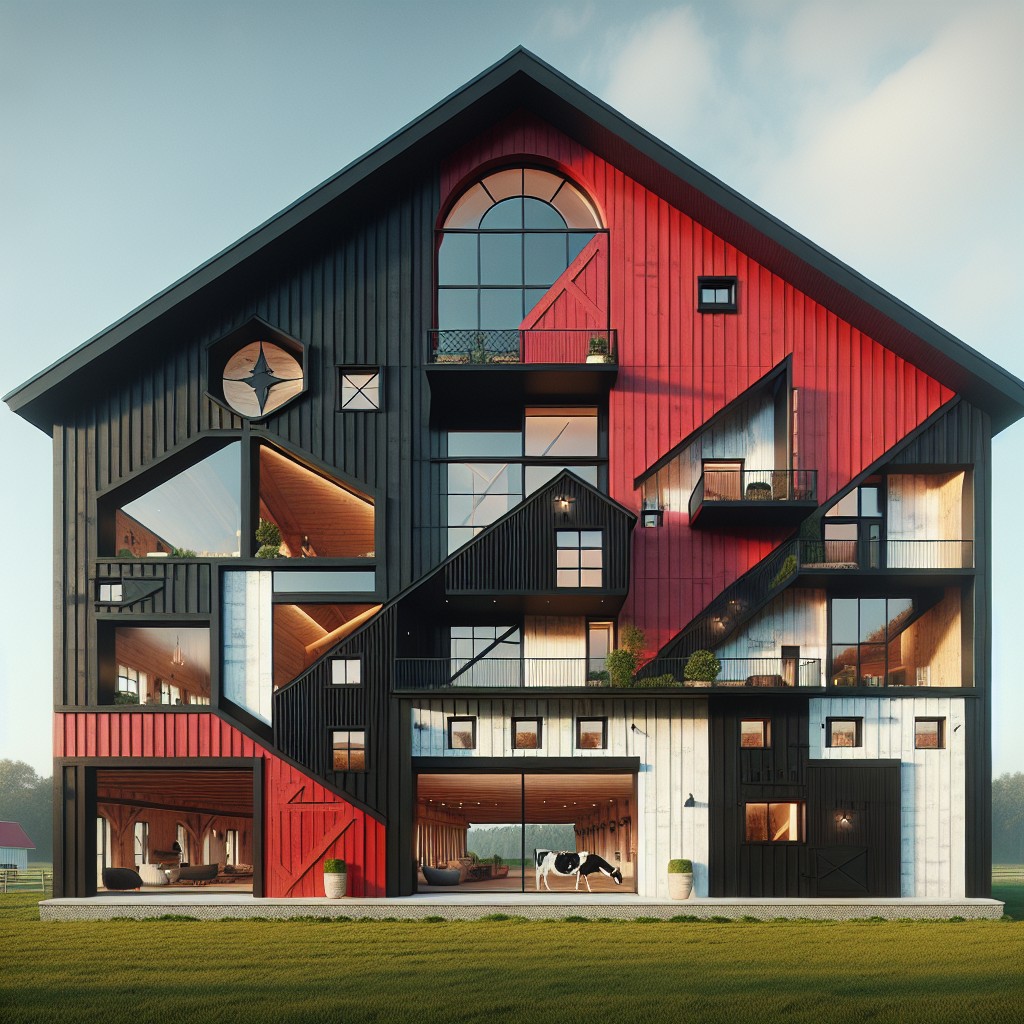
Merging old and new design features allows for a barn that honors its past while meeting contemporary needs. Here are key ways to strike this balance:
- Structural Fusion: Use traditional post and beam construction for that rustic appeal, but incorporate steel beams or accents to improve stability and add an industrial edge.
- Insulation and Energy: Retain the classic barn appearance with red and black wooden exteriors, but layer in modern, eco-friendly insulation materials and solar panels for energy efficiency.
- Windows and Lighting: Install large, energy-efficient windows to replace small, outdated ones, bringing natural light into the barn while keeping the exterior look classic.
- Doors and Hardware: Keep the sliding barn doors characteristic of traditional designs but use updated tracks and hardware for smoother operation and better durability.
- Interior Layout: Maintain an open floor plan typical of old barns but introduce modern amenities, such as updated electrical systems and plumbing for functional living spaces or workshops.
- Ventilation Systems: Use contemporary HVAC systems concealed within the classic barn structure to provide comfort without disrupting the aesthetic.
These points blend the charm of traditional barns with the convenience of modern living, creating spaces that are as functional as they are picturesque.
Interior Design Elements Complementing Red and Black Exteriors

Selecting a neutral color palette inside ensures the bold exterior doesn’t overwhelm. Consider whites, grays, and natural wood tones for walls and floors to create a serene balance.
Incorporate industrial elements such as exposed beams, metal fixtures, and concrete floors to harmonize with the traditional barn aesthetic, while also adding a modern touch.
For a cohesive feel, use accent pieces in red or black to subtly tie back to the exterior. This could be in the form of throw pillows, rugs, artwork, or small furnishings.
Opt for open concept layouts wherever possible to mimic the spacious feel of classic barn interiors, enhancing the sense of openness and light.
Prioritize natural lighting by installing large windows, skylights, or French doors, which also provide stunning views of the surrounding landscape.
Choose rustic textures like reclaimed wood for furniture and fixtures to add warmth and maintain the barn-like charm of the space.
Incorporate modern insulation and HVAC solutions to ensure the interior environment is comfortable and energy-efficient, without detracting from the design aesthetic.
Remember, the key is to marry the character of the barn with contemporary comfort, creating a space that feels both timeless and livable.
Landscape Integration for Red and Black Barns

When integrating the iconic red and black barn into the surrounding landscape, balance and harmony are key. Consider the following to enhance the aesthetic and environmental synergy:
Selecting Native Plants: Opt for vegetation native to the region. These plants will not only thrive with minimal care but also support local wildlife and maintain biodiversity.
Creating a Color Palette: Use the barn’s red and black hues to guide the selection of flowering plants and foliage. This creates a cohesive visual flow that complements the structure.
Incorporating Hardscaping: Introduce stone or gravel pathways, dry-stacked walls, or rustic fencing. These elements can echo the barn’s traditional look and provide functional outdoor spaces.
Managing Runoff: Implement rain gardens or bioswales near your barn to manage water runoff naturally. This highlights environmental stewardship and can prevent erosion.
Enhancing Seasonal Interest: Plant flora with different blooming seasons. This ensures that the barn’s surroundings remain vibrant and inviting throughout the year.
Highlighting the Entry: Design the landscape to guide visitors’ eyes to the barn’s entrance. This could involve symmetrical plantings or a tree-lined driveway that accentuates the approach.
By mindfully shaping the terrain around your red and black barn, you create a seamless transition between built and natural environments, crafting a scene that captures the imagination while honoring its setting.
Sustainable Practices in Building Red and Black Barns
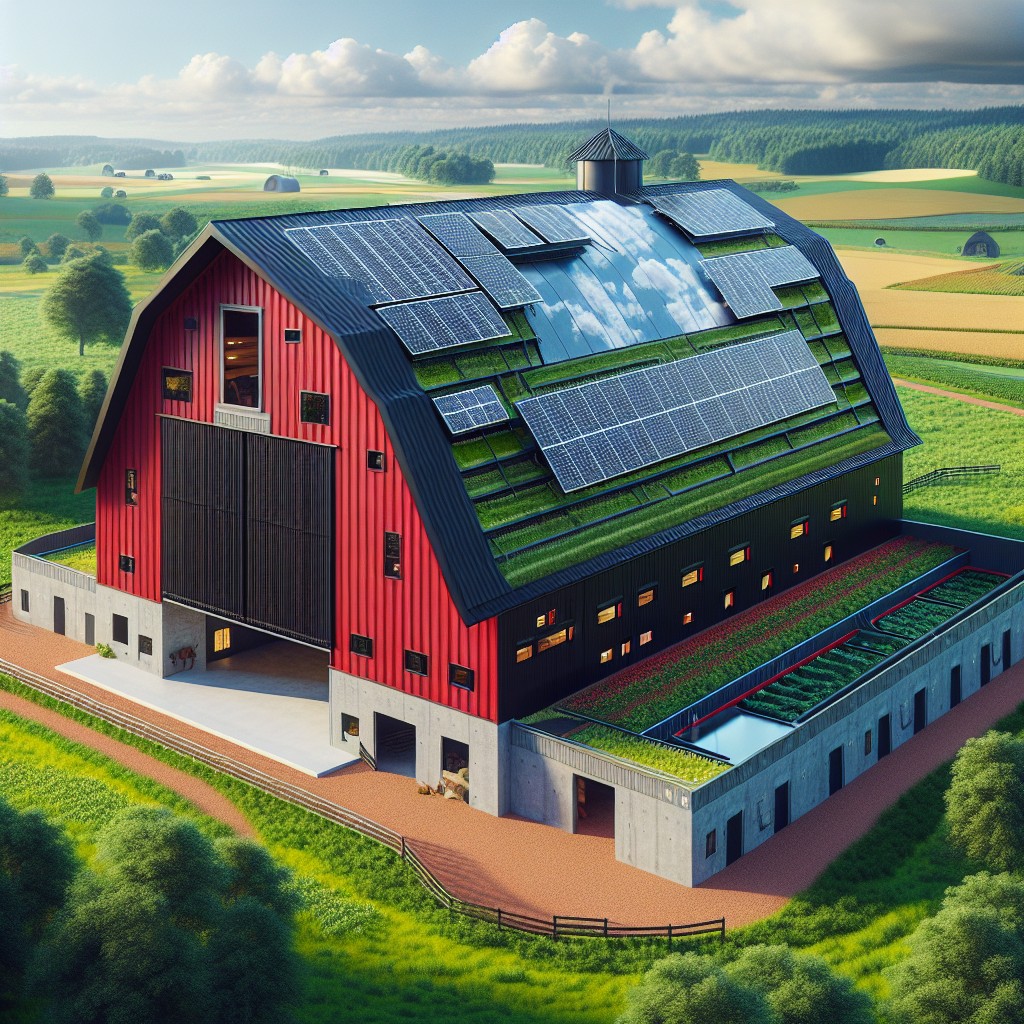
Incorporating eco-friendly materials is essential for sustainability. Opt for locally sourced wood and metal, which reduces transportation emissions and supports local economies. For the distinctive red and black hues, use low-VOC or milk-based paints that minimize harmful chemicals release into the environment.
Harness solar energy by installing solar panels on the barn roof. This step not only aligns with sustainable practices but also reduces long-term energy costs. Additionally, consider positioning windows strategically to maximize natural light and minimize the need for artificial lighting.
Rainwater harvesting systems can be integrated into the barn design, allowing rainwater to be collected from roofs and used for irrigation or livestock. This practice conserves water and reduces the burden on local water resources.
Insulation plays a significant role in sustainability; effective insulation keeps barns warm in winter and cool in summer, thereby reducing energy consumption for heating and cooling. Use recycled or natural insulating materials to enhance sustainability.
Lastly, incorporate a green roof or a living wall, which can improve insulation, absorb rainwater, and increase biodiversity. These features also add to the aesthetic appeal of red and black barns, enhancing their integration with the surrounding landscape.
Maintenance Tips for Red and Black Barn Exteriors
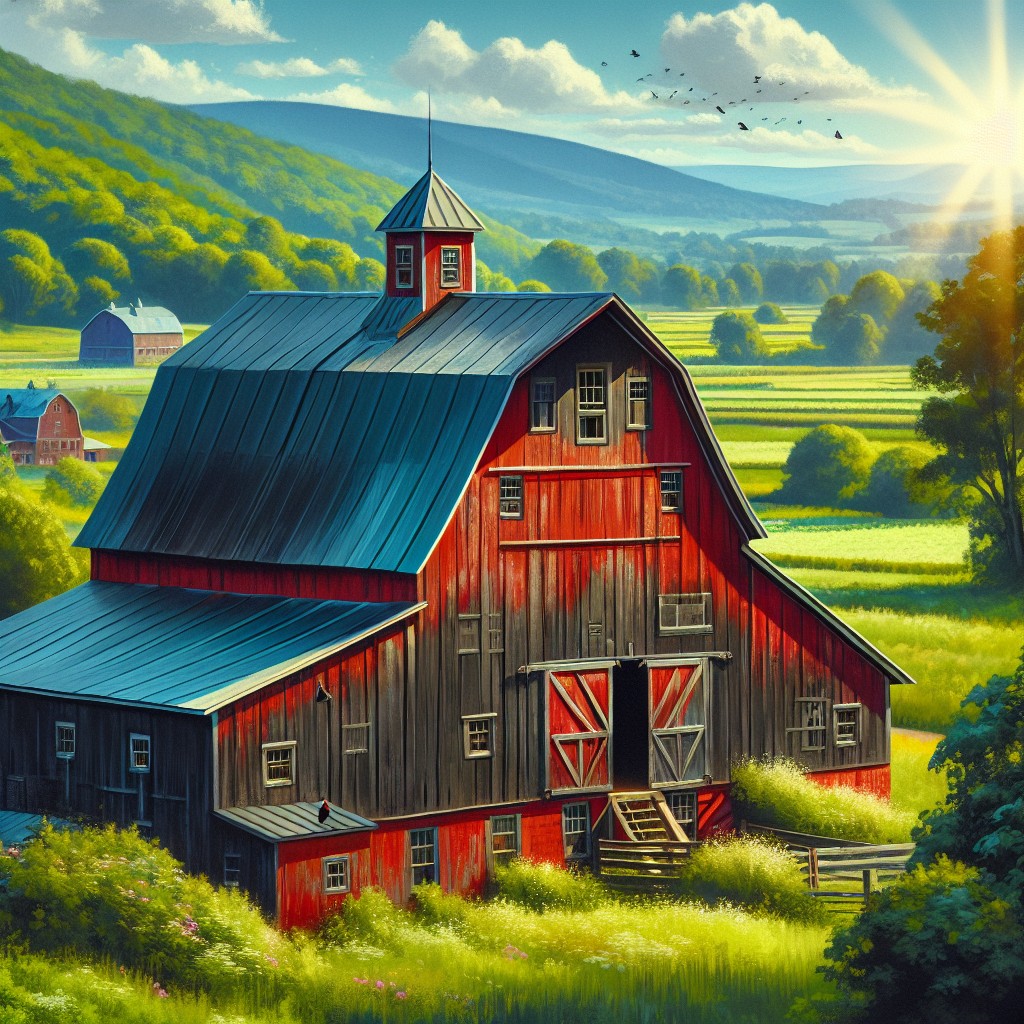
Maintaining the vibrant hue of your barn’s exterior requires regular upkeep. Start by scheduling biennial inspections to catch and repair any damage early.
When it comes to cleaning, a gentle power wash will remove dirt and debris without harming the paint. For red-painted surfaces, use a UV-resistant paint to minimize fading. To address chipping, promptly touch up paint to prevent wood rot.
Black exteriors, especially, absorb heat, so inspecting for heat damage, particularly in warmer climates, is essential. Also, consider applying a sealant every few years to protect against moisture and ensure the longevity of the wood beneath the eye-catching colors.
Keep vegetation trimmed back to prevent moisture retention and encourage airflow around the barn’s exterior. Remember, proactive care will keep your barn looking sharp and structurally sound for years to come.
How to Accomplish a Modern Black Barn Design

Achieving a modern black barn design hinges on blending functionality with a sleek aesthetic:
1. Material Choice: Utilize contemporary materials like metal siding or charred wood (Shou Sugi Ban) to offer durability and a distinct finish.
2. Clean Lines: Opt for a minimalist approach with straight lines, simple geometric shapes, and a lack of ornamental detailing to showcase modern simplicity.
3. Contrasting Elements: Incorporate contrasting materials or colors, such as natural wood or bold metal fixtures, to break up the black exterior and add visual interest.
4. Large Windows: Install floor-to-ceiling windows to create a connection with the outdoors while bringing abundant natural light into the interior spaces.
5. Open Floor Plan: Plan for an open interior layout that provides flexibility in use and emphasizes spaciousness.
6. Sustainability: Integrate green technologies such as solar panels, rainwater harvesting systems, and environmentally friendly insulation to enhance energy efficiency.
7. Lighting: Use strategic outdoor lighting to highlight architectural features and provide a warm, inviting glow during nighttime hours.
By focusing on these elements, you can craft a modern black barn design that is both timeless and grounded in contemporary style.
Black and White Barn Design Ideas
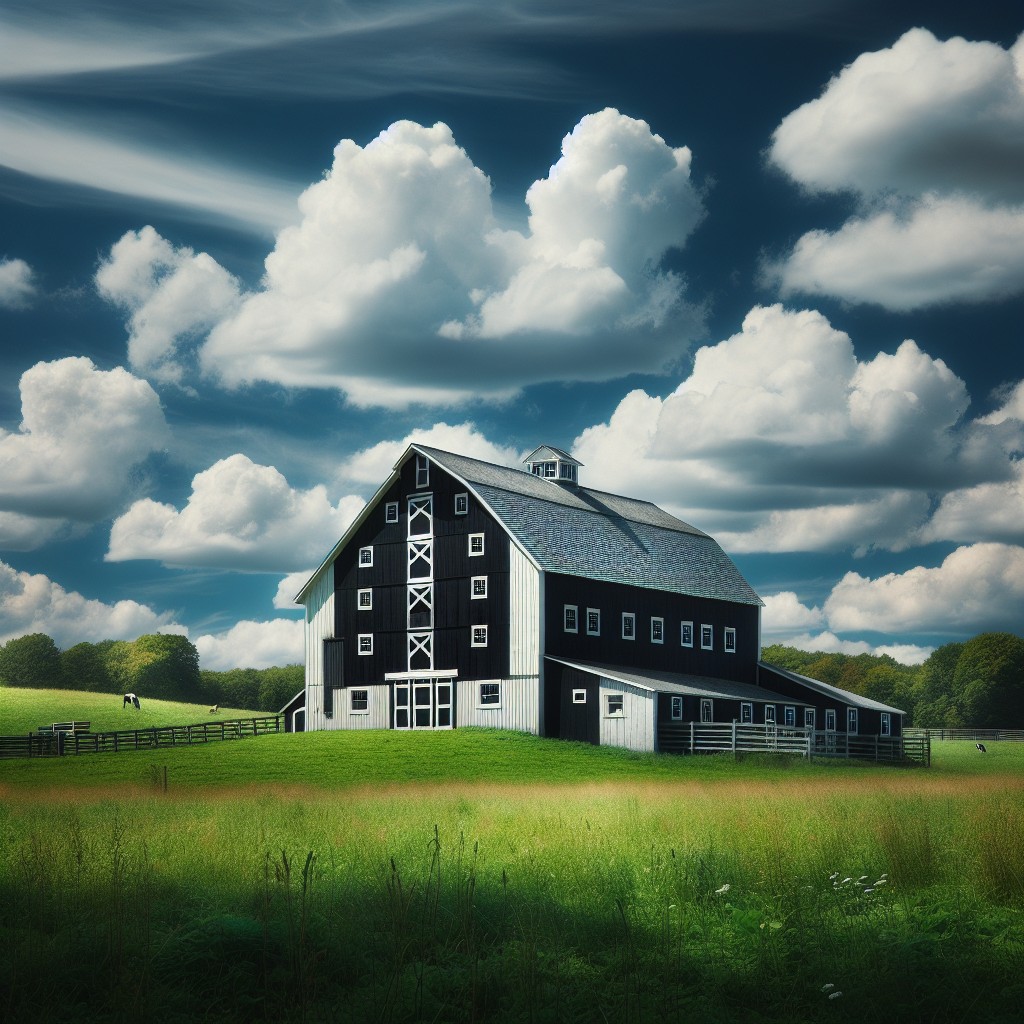
When considering black and white barn designs, focus on the contrast these colors provide. White trims against a black facade can accentuate architectural details, resulting in a striking visual appeal that is both classic and modern. Use white for window frames, eaves, and gables to break the solidity of a black exterior, lending the structure a crisp, clean edge.
Choose materials that are sustainable and require low maintenance, such as metal roofing and siding, to ensure the barn remains both functional and visually appealing over time. Incorporate large windows to not just provide ample natural light inside but to create a balanced aesthetic with the black and white theme.
Inside, aim for an open concept with high ceilings to give a spacious feel. The interior can reflect the exterior with white walls to keep the space bright and welcoming. Elements like exposed wooden beams can add warmth and a nod to the traditional barn structure.
For additional character and practicality, consider adding a cupola or weathervane atop the barn, which can be in black or white to maintain the design theme. Integrate energy-efficient features like solar panels in a way that complements the color scheme, ensuring that the design is not only beautiful but also beneficial for the environment.
FAQ
What color trim for red barn?
For a red barn, various color choices such as white for a classic, crisp look or a greenish, grey-ish, taupe for an elegant combination are suitable, but many red barns also look great without any trim color.
What makes a barn a barn?
A barn is an agricultural structure typically located on farms used for multiple purposes such as housing livestock, storing equipment, fodder, and often grain, primarily in North America.
What is barn house style?
Barn house style is a design aesthetic characterized by pitched ceilings, rustic beams and exposed wood, often coupled with modern touches like a monochromatic palette or sleek fixtures.
What are the environmental benefits of a red or black barn?
Red or black barns provide environmental benefits by absorbing heat during colder seasons, reducing the need for artificial heating, and thus saving energy.
How can traditional barn designs be updated for sustainability?
Traditional barn designs can be updated for sustainability by incorporating energy-efficient features, using sustainable building materials, and integrating natural lighting and ventilation systems.
What are key elements to consider when choosing sustainable materials for a barn-house?
When choosing sustainable materials for a barn-house, it is essential to consider the source of the materials, their energy efficiency, recyclability, durability, and impact on indoor air quality.
Related reading:
Table of Contents
